There’s a lot of talk right now about the teacher shortage crisis and the teacher attrition crisis.
This started before COVID in many areas, but the oftentimes chaotic and unpredictable approach to remote and hybrid learning this past year has made the situation more dire.
And, I can tell for sure when I listen to teachers that many more folks are planning to quit or retire early when this school year comes to an end.
So what does this mean for the teachers that stay?
How can schools keep their best teachers and attract more folks to the profession?
Obviously, this is a complex issue with many factors at play. But the fact is, many teachers are really happy with their work. There are many teachers who feel supported, have the ability to be creative and innovative in their approach, are able to focus on what’s best for kids, and aren’t bound to excessive and unnecessary paperwork or meetings.
And what I notice when observing teachers is that these conditions generally aren’t present district-wide, although some districts have higher teacher satisfaction levels than others.
Working conditions and morale vary tremendously, even between schools in the same neighborhood serving the same demographics. It’s fascinating to consider WHY teachers at two schools in the same community can have wildly different teacher retention and satisfaction rates.
I think that principals and assistant principals are the linchpins. Strong administrative leadership can make a massive difference in retaining teachers, and therefore, a massive difference in ensuring students have caring, effective, engaging instruction.
As the saying goes, people don’t quit jobs, they quit leaders. As someone who’s worked for some awesome principals, some mediocre ones, and some that were absolutely terrible … I can tell you that my actual job description and duties weren’t that different from one principal to the next. When I was unhappy and when I requested a transfer, it was never because of teaching: it was because of the school culture and leadership around teaching.
And what this means, at least to me, is that we don’t have to completely overhaul every single aspect of the school bureaucracy to better support teachers and kids. That’s a lovely goal to work toward, but in the meantime, we’re losing our best teachers and killing the love of learning in children. We need immediate solutions, as well — practical, actionable things that can be done to make teaching a more sustainable career even within our current systems.
I believe that there are leadership principles that any administrator can internalize and apply immediately to help their faculty feel better supported and create more manageable expectations. I’m going to share some of these principles in today’s episode, through the lens of what teachers have told me they wish their administrators understood.
I’ve surveyed teachers about this multiple times over the last few years, including during pandemic teaching, and I always see the same issues and patterns come up. Almost everything teachers say in response to, “What do you want your admins to know?” is some variation of or an offshoot of these five overarching statements.
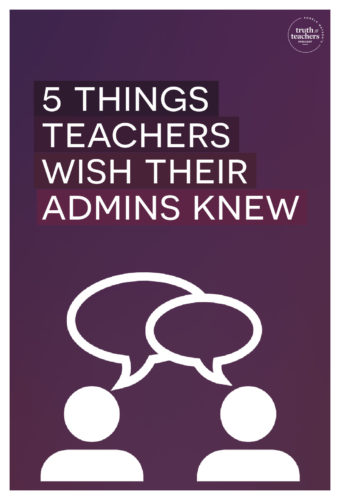
Listen to the audio below,
or subscribe in your podcast app
Sponsored by Advancement Courses and McGraw-Hill Redbird ELA & Math Bundles
1. Teachers are craving autonomy and respect for their professional judgment.
We’re living in a time in which the education pendulum has swung toward student-directed learning, giving kids choice, and differentiating everything that happens in the classroom for individual student needs.
And yet, we see the opposite movement for teachers, who are increasingly micromanaged and given one-size-fits-all professional development. They’re sitting through meetings that don’t pertain to them. They’re told they have to teach the exact same lessons as their team members and give the same homework assignments. The smallest decisions about their classroom set-up, instructional style, and so on are decided for them.
Teachers are deeply missing a sense of autonomy and the feeling that their professional judgment is respected. It can often feel like the system is constraining all teachers out of the fear that someone will do something terrible, and a scandal will wind up on the nightly news.
So, everyone has to have their lesson plans checked weekly because a handful of teachers are winging it or have insufficient plans. Everyone has to sit in on a training because a handful of folks aren’t following the policy. Everyone has to get an email reminder about report cards being due because a handful of folks never turn theirs in on time.
This leads to staff feeling micromanaged and mistrusted, and it also stifles innovation and creative thinking. If we want teachers to experiment, try new approaches, and be creative in their teaching, they must feel that their admins believe in them and give them space to be themselves.
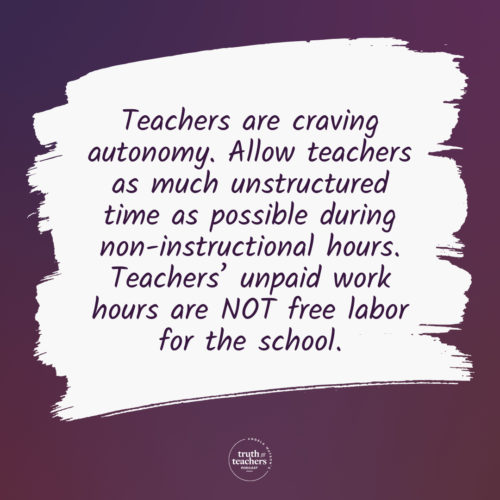
The solution: Treat all teachers like your best teachers, and provide individualized support to those who need it.
Work from a basis of trust, until that trust is broken. Don’t create additional work for teachers to be “fair,” or micromanage everyone to ensure that new teachers or struggling teachers are doing what they’re supposed to.
We do not have to accept the premise that excessive paperwork, documentation, testing, and meetings are unavoidable in education.
Every teacher does not have to submit detailed lesson plans to administration. Every school does not have to mandate multiple committee meetings. Every teacher does not have to spend hours a day on communication with parents and paperwork.
There are countless schools in which leaders have already found more effective, efficient approaches to their workload, and we owe it to our kids and teachers to innovate in this area and catch up.
The majority of a teachers’ tasks can and should be completed during the contractual day, and as a school leader, you have the power to support them in that. It’s a process of counting the cost of what we’re asking teachers to do, and begin to determine which things are worth it and which are not.
This means that if teachers are saying yes to changing out hallway bulletin board displays every month, they’re saying no to an opportunity to grade papers and give kids timely feedback on their work. If they’re saying yes to an additional committee meeting, they’re saying no to lesson preparation for the next day and higher quality instruction. If they’re saying yes to hours of catching up on schoolwork every weekend, they’re saying no to their families, health, personal development, mental clarity, and more.
Be cautious about how many initiatives your school takes on at one time, or adding a layer of accountability and paperwork without a plan for when teachers will complete it. We want teachers to accomplish the bulk of their tasks during their paid working hours. The things they do on their own time for free should be primarily things they choose to do, based on their interests (attending extracurriculars with students, finding fun lesson ideas online, participating in PD opportunities like Twitter chats and professional book clubs, etc.).
2. Teachers need uninterrupted planning time in order to be at their best for students.
It is impossible to teach well for 6 hours straight. No one can be “on” that long without losing their energy, patience, and possibly their temper. And yet most teachers are barely getting a 30-minute duty-free lunch, much less designated planning time, and they’re running copies and returning parent phone calls then, anyway.
Teacher contracts generally specify several hours of planning time per week … so why isn’t it happening?
A big part of the problem with planning time is the nationwide substitute shortage and budget constraints. These financial issues lead to teachers covering one another’s classes and/or missing out on planning time because a specials teacher is absent and there’s no one to take the class.
Also, there’s been a growing push from higher-ups at the district, state, and federal level (as well as from parents) to “hold teachers accountable” for how their time is being used. This ties into the fear-based retraction of autonomy I mentioned previously, in which we cannot possibly allow teachers an entire 45 minutes to work alone in their classrooms after school, because they might just leave early or scroll through Instagram on their phones.
So, there’s significant pressure on administrators to need to fill every minute of a teacher’s time with meetings, committees, student supervision duties, and so on to “prove” to outsiders that teachers are earning their tax-payer-funded salaries.
Fortunately, administrators hold tremendous power to disrupt this narrative.
We as educators all know that three of the most important aspects of a teachers’ job are planning high-quality instruction, delivering high-quality instruction, and assessing student learning. And, we know that none of these things can happen if teachers do not have time within the school day away from their students in which to reflect on the effectiveness of their teaching and plan their next steps.
So if we truly believe that rigorous lesson planning and assessment are instrumental for student success, we cannot expect teachers to do all of it on their own unpaid time.
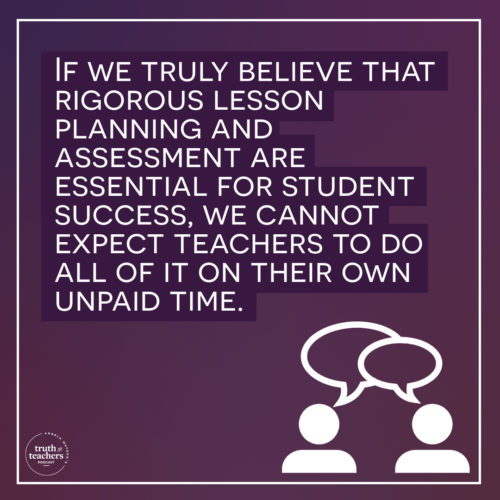
The solution: Find creative ways to provide class coverage and protect teachers’ planning time.
Even if there is a shortage of substitutes, teachers cannot be expected to routinely cover their absent colleague’s classes. This has become the norm in many schools and often the work is unpaid.
I can tell you that teachers who are regularly “voluntold” to give up their planning time are almost always on the verge of quitting. If this is a regular expectation in your school, I promise you that changing this expectation next school year will instantly lift morale AND improve the quality of instructional delivery.
So, find another way. Staff can work together to brainstorm solutions. Consider hiring hourly staff to do these kinds of duties. Have non-instructional faculty (including the admin team) rotate and fill in for teachers. Supervise the kids for an extra assembly, longer recess period, or other special events so that teachers can have additional time to work in their classrooms.
Any effort you make to show teachers you understand the value of their planning time and are doing everything you can to protect it will be appreciated.
This also includes examining how many meetings are required before and after school, as well as during planning time. Most meetings in schools are either unnecessary or last twice as long as they should. Many teachers are required to be on multiple unpaid committees and attend five or more niche-level meetings (PLCs, grade level, student data analysis, and so on).
It doesn’t have to be this way. There are relatively simple solutions for reducing meetings, streamlining committee work, and otherwise protecting teachers’ time before and after school, but you must be committed to this.
Your goal must be to allow teachers as much unstructured time as possible during their contractual hours. We want to reduce how often teachers are mandated to complete specific tasks during a given block of non-instructional time, and instead provide as much autonomy as possible so they can tackle their workload in a way that makes sense to them.
3. Teachers need administrators to have their backs, and support them when their professionalism is undermined.
One of the main reasons that teachers quit is because they do not feel like their administrators care about or support them. They get the sense that their admins are simply passing down directives from the superintendent or other higher-ups without considering how that’s going to impact teachers and their workloads, and without explaining the WHY behind new requirements.
Teachers are often presented with mandates that don’t make sense to them, and they’re not offered an opportunity to understand the bigger picture and help brainstorm possible alternative ways to meet the intended outcome in order to streamline it. The school culture is often authoritarian in nature (“Do what I say and don’t ask why; questioning me is insubordination”) vs a culture that fosters creativity, critical thinking, and innovation (“I’d love for you to help me think of alternative approaches that are more efficient and free up your planning time”).
This strong desire teachers feel to know that their leadership team has their back also applies to interactions with students’ parents and family members. Sometimes teachers feel like admins will agree to parental requests with no acknowledgement of the impact of those requests on teachers’ workloads. They might also feel that their school leaders “throw them under the bus” when parents complain.
The solution: Remember that your role as the school leader is to support your teachers so it’s easier for them to do their job well.
Administrators often feel caught in the middle, trying to please their supervisors while also keeping teachers, families, and students happy. This is an impossible task, as there’s no way to please everyone.
But administrators can choose to make more decisions based not on fear or people-pleasing but on a set of clearly-communicated core values tied to the school’s vision and mission. Admins have a significant amount of power to protect their teachers from harmful mandates and outdated, inefficient bureaucracies that don’t serve their best interests or those of students. Leaders are the linchpins, with a strong capability to disrupt the status quo reimagine systems in ways that simplify the workload for every person in the building.
A general principle of good leadership is to never shift blame to your staff when a client or stakeholder is upset. Take responsibility for the problem where relevant, and avoid bashing your teachers in front of the stakeholder. You can privately reprimand a teacher and issue consequences if needed later on, but except in instances of truly abhorrent negligence and harm on the part of a teacher, you want to present a united front.
To do otherwise undermines the authority of the teacher with that parent or stakeholder, and the next time there’s a problem, that parent will probably disrespect the teacher and then go over their head to you for intervention, continually up-leveling the problem. You want parents to believe the teacher is trustworthy and competent, and then you can provide support to the teacher behind the scenes to make sure that is true.
The goal is to actively look for ways to support your teachers and remove obstacles from their paths that keep them from doing their best. Sometimes that means reducing obligations on their time, sometimes it means shielding them from bureaucratic mandates from the district, and sometimes it means taking ownership of a tough parent situation so the teacher can relax enough to create and innovate in the classroom without distraction.
In this way, teachers will not feel like underlings or assistants who are there to carry out whatever work needs to be done by you or the district. It frees teachers to focus not on jumping through hoops for admin but on providing the best possible education to children. The job of an administration is rather simple in this regard: do everything you possibly can to help teachers with their jobs.
This mindset shift can completely transform the way you run your school and the rapport you have with your teachers.
You will not have to come up with gimmicky ways to show teachers appreciation or pry into their personal lives to try to build rapport. When teachers see that you genuinely want to support them and are working hard to simplify their jobs, they will respect you and feel comfortable being honest with you about what they need.
4. Teachers need school leaders to provide the necessary support and resources for students to be successful OR adjust expectations to align with reality.
As our schools and society become more adept at identifying special needs, mental health issues, neuro-divergent thinking, and so on, we recognize that “one-size-fits-all” education isn’t going to meet the needs of all kids. This is a good thing.
It’s only a problem when teachers are expected to differentiate and individualize for too many students in too many ways simultaneously, without the support, training, or resources needed.
Folks making decisions at the federal, state, and sometimes district level have little (if any) understanding of the true complexity of teaching, especially if they are politicians. They tend to issue sweeping decrees and leave it up to individual educators to “make it work” or “just figure it out.”
When this happens enough times over the course of many years, it’s hard to reach a conclusion other than, “These folks know it’s an impossible task and have no idea how it could possibly work, but if they don’t give specifics, they can just blame admins and teachers when the outcome is a dumpster fire.”
Schools are often set up to fail, being asked to do the impossible, and no matter what they accomplish, it won’t ever be seen as enough or celebrated. So while we do need to hold high expectations, continually improve, and not settle for less than what’s possible, we also need to be mindful of the toll that this takes on morale within the school.
It’s exhausting to continually work toward nearly impossible goals that have been set for (not with) you. This is especially true when so many of the factors determining success are completely out of your hands, and when you know meeting the goal imposed on you will only result in the expectations being raised to an even higher level.
This cycle is a major part of what causes teachers (as well as school leaders) to burn out and give up. The pressure placed on educators is also felt by students, and the incessant need to be exponentially improving can cause students to give up and drop out.
We must refuse to put such a high level of pressure on teachers and leaders in every aspect of their jobs, and instead, choose a few essential areas for them to focus on. We must make a conscious decision that some tasks in their workload are lower priorities and encourage them to do fewer things, better.
These are counter-cultural beliefs that most school districts do not operate under. They will not be easy to use as guiding principles in your decision-making. However, they are critical if we want to reduce teacher attrition and support our best educators in being successful.
Your administrative team is the de-facto intermediary between district leaders and teachers. You have the power to question bureaucratic norms and brainstorm alternatives to the status quo that work better for teachers and kids.
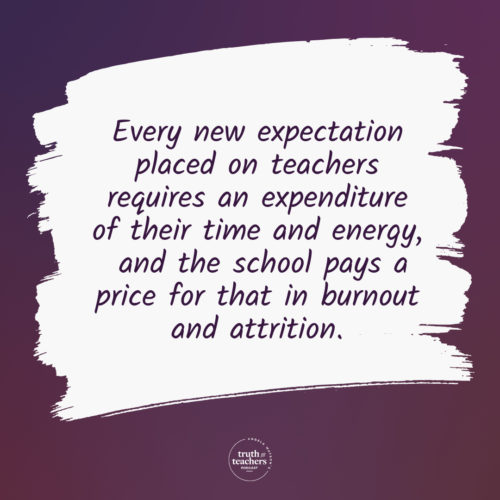
The solution: Conduct a time audit to understand where resources and energy are being allocated, and explicitly take something off of staff’s plates whenever something new is added.
A big focus in my 40 Hour Workweek program — both the existing version for teachers, and the one for school leaders which is coming out this summer — is understanding where time is being spent, and where it should be spent in order to really move the needle for kids. (Yes, 40 Hour Leadership is finally coming to life — more on that in a bit.)
Rather than just doing what’s always been done while continually adding to it and filling in gaps haphazardly, we start from the baseline and analyze what’s truly necessary and effective.
Doing everything well is not only impossible, it’s unnecessary. The responsibilities that are only marginally impactful are distracting you and your staff, causing your resources to be spread too thin, and preventing people from giving their all to the areas that could exponentially increase impact.
Admins can remove the least important tasks from their own plates and teachers’ plates, in order to free everyone up to focus on the most important initiatives. Leaders can reimagine systems in ways that simplify and reduce the workload for every person in the building.
So, administrators can take time to complete time audits like the one in the 40 Hour Leadership program:
What are the biggest priorities? What things should get the majority of their focus and energy? What things should be eliminated, streamlined, or put on the back burner for a while in order to free up time and attention for what kids MOST need us to do?
It’s important to understand that teachers’ unpaid work hours are NOT free labor for the school.
There is a limit to the amount of time a teacher can spend working without compensation, reward, recognition, or advancement. There is a breaking point beyond which their goodwill and genuine concern for students cannot be stretched.
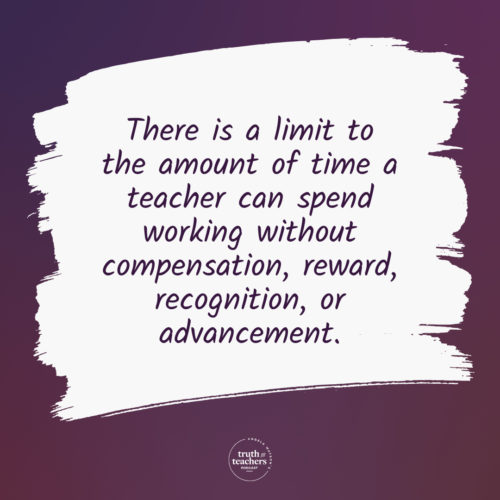
So, we have to work from the understanding that every expectation placed on teachers requires an expenditure of their time and energy, and that the school pays a price for that even if — sometimes especially if — teachers are not paid directly for that time.
A good principle to follow is this: each time you add something to teachers’ plates, take another thing off. If you’re introducing a new data collection or analysis system, figure out the overlap with the old system and explicitly tell teachers, “You no longer need to ___.”
The role of a school leader is to support teachers and make their work easier. The best bosses (in any profession) are constantly checking in with their employees to make sure they’re feeling well, have the resources and support they need, understand what’s expected of them, and believe they can be successful.
If teachers view their principal as someone who just adds more work to their plates, they will avoid and resent that person. This is similar to a marriage or romantic partnership — if the only time your partner speaks to you is when they need something, you will stop wanting to share any of your feelings or experiences with them.
So, a big part of the solution is for administrators to be mindful when they are assigning tasks to teachers or creating procedures, and view their role as a leader through the lens of “making teaching easier.” The goal is to remove as many obstacles from teachers’ paths as possible so they can focus on high-quality teaching and learning.

5. Teachers believe that an organized, efficient school leadership team with clear priorities has a tremendous positive impact on the entire school.
This sounds obvious, yet administrators — like teachers — are rarely trained in efficient workflows or in how to juggle all the responsibilities placed on them.
To compound the problem, efficiency and productivity are often not even identified as a goal within our school systems.
This leaves principals floundering to figure out their own methods to achieve specific numbers and data points, with no support in figuring out how they or their staff are supposed to fit everything in.
There’s an unspoken false equivalency between being efficient and taking shortcuts, as if doing things in a way that’s easier and faster must automatically be worse for children. To even ask about finding a way to simplify a new mandated requirement can be perceived within the educational culture as a lack of dedication or care.
We must push back against this patently dangerous myth. When a school leader is not taught how to have efficient systems in place for their work, the impact trickles down to every person in the building.
A constantly overworked and frazzled administrator creates stress for everyone around them. When admins are behind, miss deadlines, require duplicate submission of paperwork, spend inordinate amounts of time disciplining, are constantly in pointless meetings which pull them away from classrooms, and so on, it prevents every adult in the building from being their best.
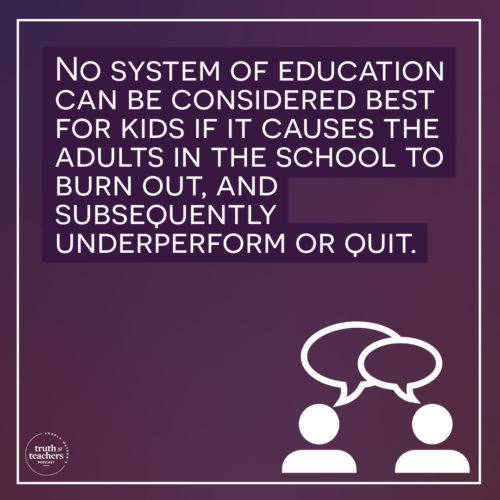
Solution: Reimagining system and norms using small yet powerful tweaks to the way we “do school” in order to recover hundreds of hours of lost time for staff.
Taking control of your own time is an essential part of being a good leader. It’s what equips you to show up each day rested, focused, and fully present with the people who need you.
Additionally, the way that you approach your work impacts how everyone else in the building approaches theirs. When you streamline your communication, meetings, email, parent correspondence, behavioral policies, and so on, you also streamline the workflow of all of your teachers.
Even with significant restrictions at the district, state, and federal level, those in school leadership have significant and often unrecognized power to transform school culture.
And, your lens becomes your practice. The way you perceive your challenges impacts the kind of solutions you can envision for them. Our goal through the 40 Hour Leadership program is to ensure you see your school through a lens that is human-centered, compassionate, and focused on what matters most (rather than upholding the status quo).
When you believe that it’s possible — and desirable — for educators to do a great job for kids and center their own work/life balance, that belief will color how you perceive your school’s operations. You will naturally filter all information and decision-making through that perception, and make decisions based on sustainable practices rather than urgent stop-gap measures.
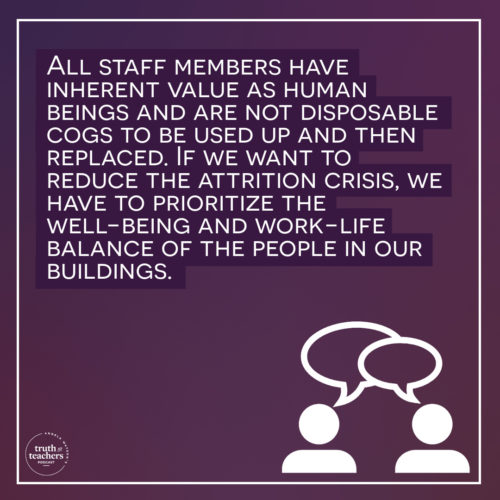
How the 40 Hour Leadership course can help
To provide guidance and coaching for that, I’m introducing the 40 Hour Leadership course that is going to be launching this summer to a beta group of admins at a special introductory price. It is a self-paced course delivered through PDF and audio modules and is designed for all K-12 schools.
40 Hour Leadership is based on the premise that no system can be considered best for kids if it causes the adults to burn out, and subsequently underperform or quit. So, we offer solutions that consider not only what’s best for kids, but also what is sustainable and manageable for the adults responsible for them.
The leadership program will be available starting in early June, which is also when the regular 40 Hour Teacher Workweek program and a new 40 Hour Instructional Coaching program will begin. Teachers can join through July 15th, and the leadership and coaching courses (which aren’t year-long programs) can be purchased anytime.
Your admin team should plan to invest about 7-10 hours into completing the 40 Hour Leadership program, with a massive return on that investment of time. There are 5 steps to the program which can be completed over the summer, or during the school year following any pace you’d like.
I hope that 40 Hour Leadership can be a supportive community of administrators who believe all staff members have inherent value as human beings and are not disposable cogs to be used up and then replaced. It’s a place for folks who know that if we want to reduce the attrition crisis, we have to prioritize the well-being and work-life balance of the people in our buildings.
We give admins simple tools to support their personal development as well as professional development, reduce extraneous and unnecessary work, and protect teachers’ instructional and planning time. It’s not going to be easy–it’s going to be worth it.
The Truth for Teachers Podcast
Our weekly audio podcast is one of the top K-12 broadcasts in the world, featuring our writers collective and tons of practical, energizing ideas. Support our work by subscribing in your favorite podcast app–everything is free!
Explore all podcast episodes
Angela Watson
Founder and Writer
OR

Join our
community
of educators
If you are a teacher who is interested in contributing to the Truth for Teachers website, please click here for more information.



















